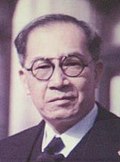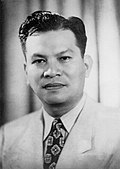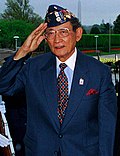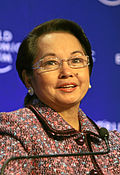List of presidents of the Philippines

Politics of the Philippines |
|---|
 |
|
Under the present Constitution of the Philippines, the president of the Philippines (Filipino: pangulo ng Pilipinas) is both the head of state and the head of government, and serves as the commander-in-chief of the country's armed forces.[4][5] The president is directly elected by qualified voters of the population to a six-year term and must be "a natural-born citizen of the Philippines, a registered voter, able to read and write, at least forty years of age on the day of the election, and a resident of the Philippines for at least ten years immediately preceding such election". Any person who has served as president for more than six years is barred from running for the position again. Upon an incumbent president's death, permanent disability, resignation, or removal from office, the vice president assumes the post.[6]
Line of succession[]
Prior to the presidential governance, the Philippines was governed by a succession of Spanish military generals during colonization by Spain. The military governors were appointed by the Spanish royals to lead the civil government of the archipelago.
In the waning years of Spanish dominion in the Philippines, a Philippine Revolution occurred. This led to the establishment of a brief revolutionary government. This occurred while Spain and the United States were both engaged in a war for control of the Philippine islands. The Americans defeated the Spanish forces seized control of the islands and undermined the revolutionary government.
Earlier under the American colonization, the president of the United States appointed four military generals. It later transferred the civil governance to an appointed governor-general, both under the Insular and Commonwealth periods. The Philippines then was considered as an overseas territory of the United States.
Presidency[]
While the line of succession of presidency is formally recognized starting with the ascension to power of Emilio Aguinaldo as a revolutionary president, it does not mean however, that the Philippines did not have a civil government prior to the Philippine Revolution.
Spain had a civilian colonial government established in the Philippine islands for over four centuries spearheaded by a governor appointed by the viceroy of Mexico. The governor runs the colonial government on behalf of the Spanish crown.
Emilio Aguinaldo became the inaugural president of the Philippines under the Malolos Republic, considered the First Philippine Republic.[7][note 2] He held that office until 1901 when he was captured by United States forces during the Philippine–American War (1899–1902).[4] The American colonization of the Philippines abolished the First Republic,[12] which led to an American governor-general exercising executive power.[19]
In 1935, the United States, pursuant to its promise of full Philippine sovereignty,[20] established the Commonwealth of the Philippines following the ratification of the 1935 Constitution, which also restored the presidency. The first national presidential election was held,[note 3] and Manuel L. Quezon (1935–44) was elected to a six-year term, with no provision for re-election,[5] as the second Philippine president and the first Commonwealth president.[note 2] In 1940, however, the Constitution was amended to allow re-election but shortened the term to four years.[4] A change in government occurred three years later when the Second Philippine Republic was organized with the enactment of the 1943 Constitution, which Japan imposed after it occupied the Philippines in 1942 during World War II.[23] José P. Laurel acted as puppet president of the new Japanese-sponsored government;[24] his de facto presidency,[25] not legally recognized until the 1960s,[11] overlapped with that of the president of the Commonwealth, which went into exile. The Second Republic was dissolved after Japan surrendered to the Allies in 1945; the Commonwealth was restored in the Philippines in the same year with Sergio Osmeña (1944–46) as president.[4]
Manuel Roxas (1946–1948) followed Osmeña when he won the first post-war election in 1946. He became the first president of the independent Philippines when the Commonwealth ended on July 4 of that year. The Third Republic was ushered in and would cover the administrations of the next five presidents, the last of which was Ferdinand Marcos (1965–86),[4] who performed a self-coup by imposing martial law in 1972.[26] The dictatorship of Marcos saw the birth of the New Society (Filipino: Bagong Lipunan) and the Fourth Republic. His tenure lasted until 1986 when he was deposed in the People Power Revolution. The current constitution came into effect in 1987, marking the beginning of the Fifth Republic.[4]
Of the individuals elected as president, three died in office: two of natural causes (Manuel L. Quezon[27] and Manuel Roxas[28]) and one in a plane crash (Ramon Magsaysay, 1953–57[29]). The longest-serving president is Ferdinand Marcos with 20 years and 57 days in office; he is the only president to have served more than two terms. The shortest is Sergio Osmeña, who spent 1 year and 300 days in office.
Two women have held the office: Corazon Aquino (1986–92), who ascended to the presidency upon the successful People Power Revolution of 1986, and Gloria Macapagal Arroyo (2001–10), who, as vice president, ascended to the presidency upon Estrada's resignation and was elected to a full six-year term in 2004.
List[]
| No. | Portrait | President (Lifespan) |
Party | Term of office (Length of tenure) |
Election | Vice president (Party; term of office, if different from president's) |
Era | ||
|---|---|---|---|---|---|---|---|---|---|
| 1 | 
|
Emilio Aguinaldo (1869–1964) |
Katipunan | January 23, 1899 – March 23, 1901[a] (2 years, 59 days) |
1899 | None[b] | First Republic | ||
| American Governors-General; from July 1, 1901 to July 1, 1902, the civil and military governor served concurrently. | August 14, 1898 – July 4, 1902 (3 years, 324 days) |
Appointed by the president of the United States, with advice and consent of the United States Senate. | U.S. military government | ||||||
| July 4, 1901 – November 15, 1935 (34 years, 134 days) |
U.S. Insular Government | ||||||||
| 2 | 
|
Manuel L. Quezon (1878–1944) |
Nacionalista | November 15, 1935 – August 1, 1944[c] (8 years, 260 days) |
1935 | Sergio Osmeña (Nacionalista) |
Commonwealth | ||
| 1941 | |||||||||
| 3 | 
|
Jose P. Laurel (1891–1959) |
KALIBAPI | October 14, 1943 – August 17, 1945[d] (1 year, 307 days) |
1943 | None[b] | Second Republic | ||
| 4 | 
|
Sergio Osmeña (1878–1961) |
Nacionalista | August 1, 1944 – May 28, 1946 (1 year, 300 days) |
1941 | Vacant[e] | Commonwealth | ||
| 5 | 
|
Manuel Roxas (1892–1948) |
Nacionalista's Liberal wing, later Liberal | May 28, 1946 – April 15, 1948[c] (1 year, 323 days) |
1946 | Elpidio Quirino (Nacionalista's Liberal wing, later Liberal) | |||
| Third Republic | |||||||||
| 6 | 
|
Elpidio Quirino (1890–1956) |
Liberal | April 17, 1948 – December 30, 1953 (5 years, 257 days) |
Vacant[e] | ||||
| 1949 | Fernando Lopez (Liberal, later Democratic; 1949–1953) | ||||||||
| 7 | 
|
Ramon Magsaysay (1907–1957) |
Nacionalista | December 30, 1953 – March 17, 1957[c] (3 years, 77 days) |
1953 | Carlos P. Garcia (Nacionalista) | |||
| 8 | 
|
Carlos P. Garcia (1896–1971) |
Nacionalista | March 18, 1957 – December 30, 1961 (4 years, 287 days) |
Vacant[e] | ||||
| 1957 | Diosdado Macapagal (Liberal; 1957–1961) | ||||||||
| 9 | 
|
Diosdado Macapagal (1910–1997) |
Liberal | December 30, 1961 – December 30, 1965 (4 years, 0 days) |
1961 | Emmanuel Pelaez (Liberal, later Nacionalista) | |||
| 10 | 
|
Ferdinand Marcos (1917–1989) |
Nacionalista, later KBL | December 30, 1965 – February 25, 1986[f] (20 years, 57 days) |
1965 | Fernando Lopez (Nacionalista; 1965–1972) | |||
| 1969 | |||||||||
| None[b] | Marcos dictatorship | ||||||||
| 1973[g] | |||||||||
| 1977[g] | |||||||||
| New Society | |||||||||
| 1981 | Fourth Republic | ||||||||
| Vacant[h] | |||||||||
| 1986 | |||||||||
| 11 | 
|
Corazon Aquino (1933–2009) |
UNIDO, later independent | February 25, 1986 – June 30, 1992 (6 years, 126 days) |
Salvador Laurel (UNIDO, later Nacionalista) | ||||
| Provisional Government | |||||||||
| Fifth Republic | |||||||||
| 12 | 
|
Fidel V. Ramos (born 1928) |
Lakas | June 30, 1992 – June 30, 1998 (6 years, 0 days) |
1992 | Joseph Estrada (NPC, later LAMMP) | |||
| 13 | 
|
Joseph Estrada (born 1937) |
LAMMP | June 30, 1998 – January 20, 2001[i] (2 years, 204 days) |
1998 | Gloria Macapagal Arroyo (Lakas) | |||
| 14 | 
|
Gloria Macapagal Arroyo (born 1947) |
Lakas, later Lakas–Kampi | January 20, 2001 – June 30, 2010 (9 years, 161 days) |
Vacant | ||||
| Teofisto Guingona Jr. (Lakas, later independent; 2001–2004) | |||||||||
| 2004 | Noli de Castro (Independent; 2004–2010) | ||||||||
| 15 | 
|
Benigno Aquino III (1960–2021) |
Liberal | June 30, 2010 – June 30, 2016 (6 years, 0 days) |
2010 | Jejomar Binay (PDP–Laban, later UNA) | |||
| 16 | 
|
Rodrigo Duterte (born 1945) |
PDP–Laban | June 30, 2016 – present (5 years, 203 days) |
2016 | Leni Robredo (Liberal) | |||
Notes[]
- ^ Term started at the inauguration of the First Republic, and ended with Aguinaldo's capture in Palanan.
- ^ a b c The constitution at this time did not create an office of the vice president.
- ^ a b c Died in office.
- ^ Term started with the inauguration of the Second Republic, and ended with Laurel's declaration of its dissolution.
- ^ a b c The constitution at this time did not mandate a selection of a new vice president after the erstwhile vice president becomes president.
- ^ Ousted after the People Power Revolution, and fled the country afterwards.
- ^ a b This was a referendum asking the electorate if the incumbent president should remain in office.
- ^ A plebiscite approved the recreation of the office of the vice president, but an election was not called until 1986.
- ^ Ousted after the Second EDSA Revolution; later declared as resigned by the Supreme Court.
Timeline[]

Notes[]
- ^ The president has three official residences, with the Malacañang Palace Complex as the principal abode and workplace.[1] The other two are Mansion House in Baguio, the official summer residence,[2] and Malacañang sa Sugbo (Malacañang of Cebu), the official residence in Cebu.[3]
- ^ a b In chronological order, the presidents started with Manuel L. Quezon,[8] who was then succeeded by Sergio Osmeña as the second president,[9] until the recognition of Emilio Aguinaldo[10] and José P. Laurel's[11] presidencies in the 1960s.[subnote 1][subnote 2] With Aguinaldo as the first president and Laurel as the third, Quezon and Osmeña are thus listed as the second and the fourth, respectively.[4][18]
- ^ Emilio Aguinaldo, the official first president, was elected by the Malolos Congress and not by popular vote.[21][22]
Subnotes
- ^ The Malolos Republic, an independent revolutionary state that is actually the first constitutional republic in Asia,[12][13] remained unrecognized by any country[14][15] until the Philippines acknowledged the government as its predecessor,[16] which it also calls the First Philippine Republic.[12][10][17] Aguinaldo was consequently counted as the country's first president.[7][10]
- ^ The Second Republic was later declared by the Supreme Court of the Philippines as a de facto, illegitimate government on September 17, 1945.[11] Its laws were considered null and void;[4][11] despite this, Laurel was included in the official roster of Philippine presidents in the 1960s.[11]
References[]
- ^ Ortiguero, Romsanne (October 22, 2014). "TRAVEL Inside Malacañang Complex, 3 places to visit for a charming date with history". News5. TV5. Archived from the original on June 30, 2016. Retrieved June 22, 2016.
- ^ "Mansion House". Presidential Museum and Library. Presidential Communications Development and Strategic Planning Office. Retrieved June 20, 2016.
- ^ Sisante, Jam (August 6, 2010). "Malacañang sa Sugbo still the president's official residence in Cebu". GMA News and Public Affairs. GMA Network. Retrieved June 20, 2016.
- ^ a b c d e f g h "The Executive Branch". Official Gazette. Presidential Communications Development and Strategic Planning Office. Retrieved June 18, 2016.
- ^ a b PCDSPO 2015, pp. 62–64
- ^ "The Constitution of the Republic of the Philippines". Official Gazette. Presidential Communications Development and Strategic Planning Office. Retrieved June 18, 2016.
- ^ a b Tucker 2009, p. 8
- ^ Quezon, Manuel Luis M. (December 30, 1941). "Second Inaugural Address of President Quezon". Official Gazette. Presidential Communications Development and Strategic Planning Office. Retrieved July 22, 2016.
- ^ Staff writer(s) (October 19, 1961). "Sergio Osmena, Second President of the Philippines". Toledo Blade. Manila: Block Communications. Retrieved July 22, 2016.
- ^ a b c Pascual, Federico D., Jr. (September 26, 2010). "Macapagal legacy casts shadow on today's issues". The Philippine Star. Retrieved July 22, 2016.
- ^ a b c d e Staff writer(s) (October 14, 2015). "Second Philippine Republic". Presidential Museum and Library. Presidential Communications Development and Strategic Planning Office. Archived from the original on March 15, 2015. Retrieved July 6, 2016.
- ^ a b c Staff writer(s) (September 7, 2012). "The First Philippine Republic". National Historical Commission of the Philippines. Retrieved June 17, 2016.
- ^ "Araw ng Republikang Filipino, 1899" [Philippine Republic Day, 1899]. Official Gazette. Presidential Communications Development and Strategic Planning Office. Retrieved June 22, 2016.
- ^ Tucker 2009, p. 496
- ^ Abueva, José V. (February 12, 2013). "Our only republic". Philippine Daily Inquirer. Retrieved June 22, 2016.
- ^ Macapagal, Diosdado (June 12, 1962). "Address of President Macapagal on Independence Day". Official Gazette. Presidential Communications Development and Strategic Planning Office. Retrieved July 23, 2016.
- ^ "Proclamation No. 533, s. 2013". Official Gazette. Presidential Communications Development and Strategic Planning Office. January 9, 2013. Retrieved July 25, 2016.
- ^ "Philippine Presidents". Presidential Museum and Library. Presidential Communications Development and Strategic Planning Office. Archived from the original on May 27, 2016. Retrieved June 15, 2016.
- ^ Agoncillo & Guerrero 1970, p. 281
- ^ "The Commonwealth of the Philippines". Official Gazette. Presidential Communications Development and Strategic Planning Office. Retrieved July 8, 2016.
- ^ "Emilio Aguinaldo". Presidential Museum and Library. Presidential Communications Development and Strategic Planning Office. Archived from the original on November 4, 2012. Retrieved June 15, 2016.
- ^ PCDSPO 2015, p. 203
- ^ Jose, Ricardo T. (1997). Afterword. His Excellency Jose P. Laurel, President of the Second Philippine Republic: Speeches, Messages and Statements, October 14, 1943 to December 19, 1944. By Laurel, José P. Manila: Lyceum of the Philippines in cooperation with the José P. Laurel Memorial Foundation. ISBN 971-91847-2-8. Retrieved June 18, 2016 – via Presidential Museum and Library.
- ^ Staff writer(s) (September 3, 1945). "The Philippines: End of a Puppet". Time. Retrieved July 5, 2016.
- ^ "Today is the birth anniversary of President Jose P. Laurel". Presidential Museum and Library. Presidential Communications Development and Strategic Planning Office. Retrieved June 18, 2016.
- ^ "Declaration of Martial Law". Official Gazette. Presidential Communications Development and Strategic Planning Office. Retrieved June 18, 2016.
- ^ Tejero, Constantino C. (November 8, 2015). "The real Manuel Luis Quezon, beyond the posture and bravura". Philippine Daily Inquirer. Retrieved June 16, 2016.
- ^ Staff writer(s) (April 16, 1948). "Heart Attack Fatal to Philippine Pres. Roxas". Schenectady Gazette. Manila. Retrieved June 16, 2016.
- ^ "Death Anniversary of President Ramon Magsaysay". Presidential Museum and Library. Presidential Communications Development and Strategic Planning Office. March 17, 2013. Retrieved June 16, 2016.
Works cited[]
- Agoncillo, Teodoro A.; Guerrero, Milagros C. (1970). History of the Filipino People (3rd ed.). Malaya Books.
- Chandler, David Porter; Steinberg, David Joel (1987). In Search of Southeast Asia: A Modern History (Revised ed.). University of Hawaii Press. ISBN 0-8248-1110-0.
- Guevara, Sulpicio, ed. (2005) [1898]. The laws of the first Philippine Republic (the laws of Malolos) 1898–1899. Compiled, edited, and translated into English by Sulpicio Guevara. Manila: National Historical Institute (published 1972). ISBN 971-538-055-7 – via University of Michigan Library.
- Philippine Electoral Almanac (PDF) (Revised and expanded ed.). Manila: Presidential Communications Development and Strategic Planning Office. 2015. ISBN 978-971-95551-6-2 – via Internet Archive.
- Tucker, Spencer, ed. (2009). The Encyclopedia of the Spanish–American and Philippine–American Wars: A Political, Social, and Military History. 1 (Illustrated ed.). ABC-CLIO. ISBN 978-1-85109-951-1.
External links[]
| Wikimedia Commons has media related to Presidents of the Philippines. |
- Lists of national presidents
- Lists of political office-holders in the Philippines
- Lists of presidents of the Philippines
